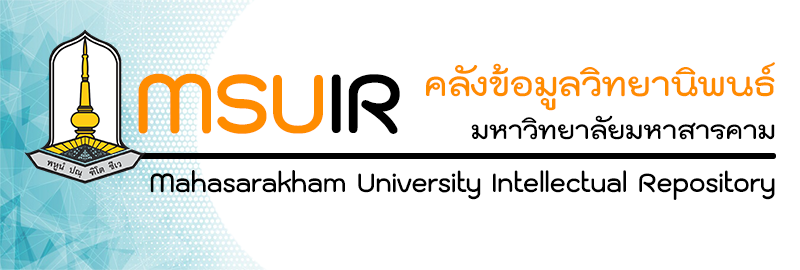Please use this identifier to cite or link to this item:
http://202.28.34.124/dspace/handle123456789/2671| Title: | Drying of black soldier fly with rotation hot air for cricket feed การอบแห้งหนอนแมลงวันลายด้วยลมร้อนแบบถาดหมุนเพื่อเป็นอาหารจิ้งหรีด |
| Authors: | Nuntawat Butwong นันทวัฒน์ บุตรวงค์ Sopa Cansee โสภา แคนสี Mahasarakham University Sopa Cansee โสภา แคนสี sopa.c@msu.ac.th sopa.c@msu.ac.th |
| Keywords: | การอบแห้ง หนอนแมลงวันลาย เครื่องอบแห้งลมร้อนแบบถาดหมุน แบบจำลองทางคณิตศาสตร์ จิ้งหรีด อาหารลดต้นทุน black soldier fly local ingredient feeding drying rotating tray drying mathematical model the drying Cricket |
| Issue Date: | 10 |
| Publisher: | Mahasarakham University |
| Abstract: | Drying black soldier fly larvae using a hot air rotating tray dryer for cricket feed. The objective of this study was to examine the drying behavior, specific energy consumption, effective moisture diffusivity, and mathematical modeling of thin-layer drying equations of black soldier fly larvae using a hot air rotary tray dryer to be used as cricket feed. The drying factors included three drying temperatures (50, 60, and 70 degrees Celsius) and three rotary tray speeds (0, 5, and 10 RPM) at an average air velocity of 3 meters per second. The experimental procedure involved preparing 300 grams of black soldier fly larvae per sample with an average thickness of 5 millimeters. Initial moisture content was randomly measured before drying with the rotary tray dryer, and weight changes were recorded every 30 minutes until the final moisture content reached approximately 10% w.b. The dried larvae were then finely ground to be mixed with local agricultural feed ingredients (soybean meal, corn, rice) and tested in four different feed formulas for crickets (0%, 25%, 50%, and 75% black soldier fly larvae) using Person’s square method. Three cost-reduced formulas were derived and compared to commercial cricket feed. The trials used 21-25 day old crickets (pre-adult stage), with 900 grams of crickets per square meter of rearing space. Data on feed intake and weight were recorded to study the feed conversion ratio (FCR) and efficiency of conversion of ingested feed (ECI).
The results showed that the initial moisture content of black soldier fly larvae ranged from 64.2-67.1% w.b. Drying the larvae with the hot air rotary tray dryer at different temperatures and rotary tray speeds indicated that increasing temperature and tray speed increased the drying rate. The lowest specific energy consumption and shortest drying time were achieved at 70 degrees Celsius and 10 RPM, with a specific energy consumption of 10.37 MJ/kg of evaporated water. The effective moisture diffusivity ranged from 2.53 x 10-9 to 1.04 x 10-8 square meters per second. Predicting the moisture ratio using eight thin-layer drying models, analyzed by nonlinear regression, revealed that the Logarithmic model provided the best predictions at 50, 60, and 70 degrees Celsius and 0, 5, and 10 RPM, with higher R2 and lower χ2 and RMSE values compared to other models. Testing the feed mixture with commercial cricket feed showed that a 50% black soldier fly larvae mix resulted in an FCR of 2.25 and an ECI of 44.38%. Cost-reduction trials using Person’s square method found that the second cost-reducing feed formula yields a final cricket weight yield of 99.89%, which is the highest when compared to other food recipes, and can reduce feed costs by up to 33.25%. การอบแห้งหนอนแมลงวันลายด้วยเครื่องอบแห้งลมร้อนถาดหมุนเพื่อใช้เป็นอาหารจิ้งหรีด มีวัตถุประสงค์เพื่อ ศึกษาพฤติกรรมการอบแห้ง ค่าความสิ้นเปลืองพลังงานจำเพาะ สัมประสิทธิ์การแพร่ความชื้นประสิทธิผล และแบบจำลองทางคณิตศาสตร์ของสมการอบแห้งชั้นบาง มีปัจจัยการอบแห้ง คือ อุณหภูมิอบแห้ง 3 ระดับ (50 60 และ 70 องศาเซลเซียส) ความเร็วรอบถาดหมุน 3 ระดับ (0 5 และ 10 รอบต่อนาที) ที่ความเร็วลมเฉลี่ย 3 เมตรต่อวินาที มีวิธีการการดำเนินการทดลอง โดยการเตรียมหนอนแมลงวันลายจำนวน 300 กรัมต่อตัวอย่าง มีความหนาเฉลี่ย 5 มิลลิเมตร สุ่มหาความชื้นเริ่มต้น ก่อนนำไปอบด้วยเครื่องอบแห้งลมร้อนถาดหมุน และทำการบันทึกข้อมูลน้ำหนักที่เปลี่ยนแปลงทุกๆ 30 นาที จนความชื้นสุดท้ายประมาณ 10 %w.b. และนำหนอนแมลงวันลายไปบดละเอียด เพื่อเป็นส่วนผสมกับพืชอาหารสัตว์ในท้องถิ่น (กากถั่วเหลือง ข้าวโพด ข้าวสาร) และทำการทดลองการผสมหนอนแมลงวันลายร่วมกับอาหารเลี้ยงจิ้งหรีดเชิงพาณิชย์ทั้งหมด 4 สูตร (ผสมหนอนแมลงวันลาย 0% 25% 50% และ 75%) เพื่อนำข้อมูลที่ได้ไปใช้ ก่อนทำการผสมร่วมกับพืชอาหารสัตว์ในท้องถิ่นด้วยวิธี Person’s square ซึ่งได้อาหารลดต้นทุนได้ทั้งหมด 3 สูตร เพื่อเปรียบเทียบกับอาหารเลี้ยงจิ้งหรีดเชิงพาณิชย์ ซึ่งในการทดลองใช้จิ้งหรีดอายุ 21-25 วัน (ระยะก่อนโตเต็มวัย) โดยใช้ตัวอย่างจิ้งหรีดมีน้ำหนัก 900 กรัมต่อบ่อเลี้ยงขนาด 1 ตารางเมตร และทำบันทึกข้อมูลการกินอาหาร และชั่งน้ำหนักจิ้งหรีดก่อนเก็บผลผลิตจิ้งหรีดเพื่อศึกษาค่าอัตราการเปลี่ยนอาหารเป็นน้ำหนัก (FCR) และ ประสิทธิภาพการใช้อาหาร (ECI) ต่อไป จากการทดลองพบว่าความชื้นเริ่มต้นในการอบแห้งหนอนแมลงวันลายอยู่ในช่วง 64.2-67.1 %w.b. ส่วนการอบแห้งหนอนแมลงวันลายด้วยเครื่องอบแห้งลมร้อนถาดหมุนที่อุณภูมิลมร้อน และความเร็วรอบถาดหมุนแต่ละปัจจัย พบว่า เมื่ออุณหภูมิและความเร็วรอบการหมุนถาดเพิ่มขึ้น จะทำให้อัตราการอบแห้งเพิ่มมากขึ้น โดยค่าความสิ้นเปลืองพลังงานจำเพาะและใช้ระยะเวลาในอบแห้งที่ต่ำที่สุด คือ อุณหภูมิ 70 องศาเซลเซียส ความเร็วรอบถาดหมุน 10 รอบต่อนาที มีค่าความสิ้นเปลืองพลังงานจำเพาะ เท่ากับ 10.37 เมกะจูลต่อกิโลกรัมของน้ำระเหย ค่าสัมประสิทธิ์การแพร่ความชื้นประสิทธิผลจะอยู่ในช่วง ในช่วง 2.533 x 10-9 ถึง 1.04 x 10-8 ตารางเมตรต่อวินาที นอกจากนี้จากการทำนายอัตราส่วนความชื้นของการอบแห้งหนอนแมลงวันลายด้วยแบบจำลองทางคณิตศาสตร์ของการอบแห้งชั้นบาง 8 แบบจำลอง โดยทำการวิเคราะห์ด้วยวิธีถดถอยแบบไม่เป็นเชิงเส้นตรง พบว่าอุณหภูมิ 50 60 และ 70 องศาเซลเซียส ความเร็วรอบถาดหมุน 0 5 และ 10 รอบต่อนาที แบบจำลองของ Logarithmic จะให้ผลทำนายที่ดีที่สุด โดยให้ค่า R2 มากกว่า ในขณะที่ χ2 และ RMSE น้อยกว่าแบบจำลองอื่นๆ และจากการทดสอบการผสมหนอนแมลงวันลายร่วมกับอาหารเลี้ยงจิ้งหรีดเชิงพาณิชย์ พบว่า การผสมหนอนแมลงวันลาย 50% อัตราการเปลี่ยนอาหารเป็นน้ำหนัก (FCR) มีค่าเท่ากับ 2.25 และ ประสิทธิภาพการใช้อาหาร (ECI) มีค่าเท่ากับ 44.38% และจากการทดสอบการผสมลดต้นทุนด้วยวิธี Person’s square พบว่า สูตรอาหารลดต้นทุนที่ 2 ให้ผลผลิตน้ำหนักจิ้งหรีดสุดท้าย เท่ากับ 99.89% ซึ่งมากที่สุดเมื่อเปรียบเทียบกับสูตรอาหารอื่น ๆ และสามารถลดต้นทุนอาหารได้ถึง 33.25% |
| URI: | http://202.28.34.124/dspace/handle123456789/2671 |
| Appears in Collections: | The Faculty of Engineering |
Files in This Item:
| File | Description | Size | Format | |
|---|---|---|---|---|
| 64010351002.pdf | 7.66 MB | Adobe PDF | View/Open |
Items in DSpace are protected by copyright, with all rights reserved, unless otherwise indicated.

